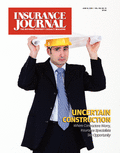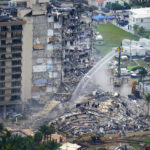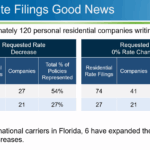“The recent attacks in London, Paris and the Boston marathon bombing are evidence that terrorists are resorting to simpler tactics,” said Mark Lynch, the head of Political Risk Model Development at Aon Benfield’s Impact Forecasting. “They have more opportunities and can use household products [knives in London and Paris, easily available chemicals in a pressure cooker in Boston]. It’s difficult to stop.”
The threat to society from lone individuals and organized groups, dedicated to committing violent acts to express their grievances, has been a fact of life for a very long time. In the past the main targets were public officials, most prominently the assassination of Archduke Duke Franz Ferdinand in 1914, which set off the First World War.
More recently, however, terrorists have greatly expanded their targets, planting bombs in public places, hijacking airplanes, kidnapping or holding hostage workers and business people [the recent siege of a gas plant in Algeria] and committing other random acts of violence. Protracted mayhem now occurs almost on a daily basis in many countries, notably Syria, Iraq, Afghanistan, Somalia and Pakistan, which are, or are close to becoming, war zones.
While western and more developed nations aren’t in that category, they are nonetheless exposed to the threat of terrorism. The U.S., the UK, Spain, Germany, Lebanon and elsewhere have all been hit by terrorist attacks over the last 40 years that have cost thousands of lives and billions of dollars.
Why has the terrorist presence remained so prominent? “It continues to be employed because it works,” Lynch said. “They are sometimes successful and they get publicity.” He cited the kidnapping and murder of the Israeli Olympic team in Munich in 1972 as an early example. It significantly increased the world’s awareness of the grievances embedded in Palestinians by Israel’s occupation and seizure of what they considered their lands. The bombing of the U.S. Marine barracks in Lebanon in 1983 forced the U.S. to end its military presence in the country.
“Terrorist groups seek to maintain their exposure, and to get their message across,” said Lynch. Their high profile acts also “attract new recruits and increase the status of their members within their peer group.” If one attack is successful, it spawns “copycat” attacks. A British soldier is stabbed to death in London; a day later a French soldier is stabbed in Paris.
Of all the western countries the UK probably has more experience with terrorism than any other, due in large part to the 700 year conflict over the occupation of Ireland and the settlement reached in 1922 that split the island into two countries – Northern Ireland remaining British.
After relative quiescence, the conflict broke out anew in 1968 with demonstrations in Derry (UK-Londonderry) over the heavy handed actions of the local government. For the next 30 years Northern Ireland, the Irish Republic and the UK experienced a wave of bombings, targeted killings, riots and other violence, until the “Good Friday Agreement,” concluded on April 10, 1998, finally established a new working relationship and brought a measure of peace.
The reaction to the “Troubles” ranged from brutal to benign, but it also had consequences for the insurance industry. Following the Bishopsgate bombing in London’s financial district, which caused huge property losses, along with one death and many injuries, the UK established Pool Re to take on terrorist risks that would otherwise have been uninsurable.
It also created a need for more accurate information on how to predict terrorist threats and what the results of an attack might be. In short the insurance industry was called upon to model terrorist risks, as it models natural disaster risks. Lynch and his colleagues at Aon Benfield have been doing just that, and have produced the first models covering the UK and Germany. From there they will analyze France and other European countries before turning to the U.S. and Latin America.
The blueprint they have produced notes that “while terrorism modeling is a relatively new field in catastrophe modeling, it has grown more prominent in the wake of a number of large market losses stemming from terrorism.” As a result it requires a “completely different approach to address the risk, compared to natural hazards.” There is “greater emphasis on the validity of expert input, flexibility and qualitative analysis.”
The blueprint features maps with each potential target across “key areas” identified. The sites selected are “of strategic importance and represent military, political or ’emotive’ value.” The maps can correlate the distance between a given potential target and the property for which coverage may be sought. The targets are “configured with help from local security consultants and government agencies.” They lay out “damage curves” that have been extrapolated from “over 20 different attack types,” including actual blast tests.” The model can “encapsulate the risk” to property, business interruption, life, accident and health lines.
A number of the targets are “symbolic,” Lynch said. They include “airports, train stations and other transport sites.” The 20 different types of attacks range from a lone individual with a knife or other weapon, which Lynch pointed out “is almost impossible to predict,” to an attack with a nuclear device and to a lesser extent chemical and biological weapons.
He explained that although the nuclear scenario is the most drastic, it’s also one of the least likely to occur. “An attack with a nuclear device needs state sponsorship. You also have to transport it across borders, and to detonate it is very difficult, requiring real expertise.” The “majority of our consultants” see the possibility of a nuclear attack as extremely remote.
He also downplayed the potential threat from biological and chemical weapons, as they are deadly at close range, but they disperse quite rapidly and can be analyzed quickly. As an example he cited the attack on the Tokyo subway with sarin. The cult that perpetrated the attacks aimed “to kill thousands,” but comparatively few people were actually killed or injured.
“The real threat comes from lower grade conventional weapons, especially suicide bombs. Planting a bomb in a crowded area – as in the London and Madrid bombings and the Boston Marathon bombing – causes significant loss of life and serious property damage. Lynch pointed out that suicide bombers are especially deadly because they can choose when and where they will detonate their explosives, thereby seeking to create the maximum amount of death, injury and damage.
Terrorists exist in most countries, but their nature varies depending on what they are seeking and how they are organized. While many attackers claim a connection with Al Qaida, “they are usually smaller self-organized groups or cells,” Lynch said. “Al Qaida has become more like a franchise. They use the name to attach importance to their message and to get more publicity.”
It is actually the individuals and small cells that are the hardest to model and predict, as well as to identify. “A knife attack is almost impossible to prevent,” Lynch said. The only way to do so is increased “surveillance, but we have finite resources.” He estimated, however, that the security services do a pretty good job, managing to prevent around 80 percent of potential terrorist attacks, “but it’s impossible to stop them all.”
Of necessity models for terrorism deal with the microcosm, the individual threat level to any given potential target. But there’s also the macrocosm, the ongoing wars, revolutions and extended conflicts that provide fodder, both for the commission of terrorist acts and the people who are led to commit them. A litany of the world’s trouble spots includes most of North Africa, practically all of the Middle East, Chechnya, parts of Asia and Latin America, many countries in Sub Saharan Africa, and, prominently Afghanistan and Pakistan.
Lynch explained that in the near term these conflicts actually reduce the threats of terrorist attacks in other countries, as many committed individuals join one side or another. France estimates that about 50 of its citizens are fighting in Syria, the UK estimates around 100.
However, the experience these individuals gain increases the threat they pose over the long term. Many return from these conflicts as battle hardened guerrilla fighters with extensive knowledge of how to construct and place bombs, or carry out armed attacks. They may also have an established base from which to operate and a supply of weapons and explosive materials.
Trying to create an accurate model for terrorism may not be an impossible job, but it is certainly a difficult one, especially, as Lynch pointed out, “the threat from terrorism changes significantly over time.” Nonetheless, Aon Benfield has targeted 2015 as the year when it will have completed the models for terrorist risks in most countries. That will be a significant step forward in identifying the threats those countries face.
Topics Catastrophe Natural Disasters USA Aon London
Was this article valuable?
Here are more articles you may enjoy.


 Erie Insurance Restores Online Access for Customers; Still Working on Other Systems
Erie Insurance Restores Online Access for Customers; Still Working on Other Systems  DeSantis Signs Law Giving Condo Owners Some Relief, But Questions Remain
DeSantis Signs Law Giving Condo Owners Some Relief, But Questions Remain  US E&S Growth Slowed Again in ’24; Berkshire, AIG Top Premium Rankings
US E&S Growth Slowed Again in ’24; Berkshire, AIG Top Premium Rankings  Slide’s Exec Pay Leads to Questions About Florida Citizens’ Rate Model
Slide’s Exec Pay Leads to Questions About Florida Citizens’ Rate Model 

